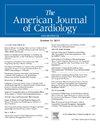IF 2.3
3区 医学
Q2 CARDIAC & CARDIOVASCULAR SYSTEMS
引用次数: 0
摘要
尽管三尖瓣经导管边缘到边缘修补术(TEER)在治疗三尖瓣反流方面具有潜在的疗效,而且在非老年人群中观察到的严重并发症发生率较低,但有关接受该手术的八旬老人围手术期疗效的数据却很少。我们评估了八旬老人与在一家转诊三级教学医院接受治疗的 80 岁以下患者相比,TEER 的特征和疗效。我们回顾性地纳入了所有接受三尖瓣 TEER 的成年患者。根据年龄对人群进行了分层:≥80 岁和本文章由计算机程序翻译,如有差异,请以英文原文为准。
Outcomes of Octogenarians Undergoing Edge-to-Edge Transcatheter Valve Repair for Tricuspid Regurgitation: Inverse Propensity Score-Weighted Analysis
There is a scarcity of data for perioperative outcomes of octogenarians undergoing tricuspid transcatheter edge-to-edge repair (TEER), despite both the potential procedural effectiveness in treating tricuspid regurgitation and a low incidence of severe complications observed in the nonelderly population. We assessed the characteristics and outcomes of TEER in octogenarians compared to those in patients under 80 years old treated at a referral tertiary teaching hospital. We retrospectively enrolled all adult patients undergoing tricuspid TEER. The population was stratified based on age: ≥80 and <80 years. Inverse probability of treatment weighting (IPTW) propensity score was used to mitigate the risk of selection bias. Between January 2017 and September 2023, 101 patients underwent tricuspid TEER. Thirty-six (36%) were octogenarians. Crude treatment estimates indicated that preoperative Tricuspid Annular Plane Systolic Excursion (TAPSE) was significantly higher in octogenarians compared to younger patients (19 mm [IQR: 17 to 21] vs. 17 mm [IQR: 14–18]; p = 0.005). At discharge, octogenarians showed a TAPSE 2.71 mm higher than that observed in the <80 age group (95% CI: 0.79 to 4.62; p = 0.006) according to crude treatment estimates. After adjusting with IPTW-weighting, the TAPSE difference remained significant, with octogenarians having a 2.44 mm higher TAPSE (95% CI: 0.54 to 4.35; p = 0.012). IPTW-adjusted analyses indicated comparable clinical outcomes between the two groups. Adverse events and survival in octogenarians were similar to those observed in patients aged <80 years. Our findings indicate that age alone should not be the sole criterion to deny TEER.
求助全文
通过发布文献求助,成功后即可免费获取论文全文。
去求助
来源期刊

American Journal of Cardiology
医学-心血管系统
CiteScore
4.00
自引率
3.60%
发文量
698
审稿时长
33 days
期刊介绍:
Published 24 times a year, The American Journal of Cardiology® is an independent journal designed for cardiovascular disease specialists and internists with a subspecialty in cardiology throughout the world. AJC is an independent, scientific, peer-reviewed journal of original articles that focus on the practical, clinical approach to the diagnosis and treatment of cardiovascular disease. AJC has one of the fastest acceptance to publication times in Cardiology. Features report on systemic hypertension, methodology, drugs, pacing, arrhythmia, preventive cardiology, congestive heart failure, valvular heart disease, congenital heart disease, and cardiomyopathy. Also included are editorials, readers'' comments, and symposia.
 求助内容:
求助内容: 应助结果提醒方式:
应助结果提醒方式:


